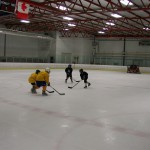After recently writing a Facebook blog on injuries in the NHL, I remembered another situation that causes many injuries in all levels of hockey – that I feel needs to be addressed. That specific action is looking over your shoulder to receive a pass. Many injuries occur when a player skates  ahead of the puck and looks behind him to receive the pass. This is usually referred to as the “suicide pass”. In our IHC tournament team practices, I am always emphasizing the need to create “speed behind the puck” and support on the defensive side of the puck. What this means is that the pass receiver needs to skate below the puck carrier and then start accelerating up ice. He can now receive a pass with speed and facing open ice so he is not vulnerable to any blind side hits. This is especially effective on breakouts so the pass receiver can enter the neutral zone with speed. He is also supporting on the defensive side of the puck where he skates below the puck. Now if the puck carrier loses the puck, he has support on the defensive side of the puck. Also, most NHL teams are using speed behind the puck in the neutral zone on their power plays. This allows the team to enter the offensive zone with speed and puck possession.
ahead of the puck and looks behind him to receive the pass. This is usually referred to as the “suicide pass”. In our IHC tournament team practices, I am always emphasizing the need to create “speed behind the puck” and support on the defensive side of the puck. What this means is that the pass receiver needs to skate below the puck carrier and then start accelerating up ice. He can now receive a pass with speed and facing open ice so he is not vulnerable to any blind side hits. This is especially effective on breakouts so the pass receiver can enter the neutral zone with speed. He is also supporting on the defensive side of the puck where he skates below the puck. Now if the puck carrier loses the puck, he has support on the defensive side of the puck. Also, most NHL teams are using speed behind the puck in the neutral zone on their power plays. This allows the team to enter the offensive zone with speed and puck possession.
Youth hockey players are skating away from the puck much too often and they have to be taught the importance of speed behind the puck, and supporting their teammates on the defensive side of the puck. Not only will they benefit from this technique by not putting themselves in a vulnerable position for suicide passes, but it will also create much more speed, smoother breakouts, better entries, and offense for your team.

Leave a Comment